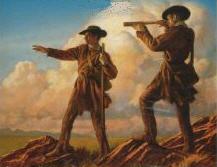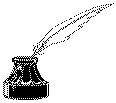
|
"We set out early and proceeded on..." |

|
"We set out early and proceeded on..." |
|

|
"The other objects of this mission are scientific, and of course not less interesting to the U. States than to the world generally, such as ascertaining by celestial observation the geography of the country through which I shall pass; the names of the nations who inhabit it [...]; their languages, traditions, and monuments [...]; the diseases prevalent among them and the remidies they use [...]; the soil and face of the country; it's growth and vegtable productions, its animals; the mineral productions of every description; and in short to collect the best possible information relative to whatever the country may afford as a tribute to general science." The Lewis and Clark Expedition was the first U.S.-sponsored scientific exploration, and a key early scientific survey of the American West. Lewis and Clark made important discoveries in zoology, botany, ethnology, and geography, and described for the first time more than 170 plants and more than 100 species and subspecies of animals entirely new to science. Clark's excellent maps and records of geography were an immediate and lasting aid to opening the west. Only Lewis's untimely death, which frustrated publication of his notes and reports, and the loss and fragmentation of the collections, prevented him from being widely recognized as an important American naturalist until years later after many others had duplicated his discoveries. Lewis and Clark: Pioneering Naturalists, Paul Russell Cutright, University of Illinois Press, 1969, 506 + xii pages. A excellent history of all the expedition did, with extra information on plants and animals reported and discovered for science. Over fifty pages of appendices list and describe scientific discoveries in detail, the single best such listing. Another appendix lists the location of all known surviving artifacts and specimens, at the time of publication. The Natural History of the Lewis and Clark Expedition. Raymond Darwin Burroughs. Michigan State University Press, 1961, reprinted 1995, 340 pages. Detailed information about animals encounters and scientific observations with journal extracts. Not a chronological account of the expedition, this book has chapters for different kinds of animals. There are detailed and authoritative natural history notes in Gary Moulton's editions of the complete journals (Univ. of Nebraska 1982-2001). American Science in the Age of Jefferson, John C. Greene, The Iowa State University Press, 1984, 484 + xiv pages. Provides a detailed examination of the science of the day; Chapter 8 discusses the Lewis and Clark Expedition. Thomas Jefferson and the Stony Mountains; Exploring the West from Monticello. Donald Jackson. University of Illinois Press. 1981. Our Natural History: The Lessons of Lewis and Clark. Daniel Botkin, Perigee, 1995. A perspective on the natural world of the American west today compared to what Lewis and Clark saw.
Plants of the Lewis & Clark Expedition. H. Wayne Phillips. Mountain Press Publishing Company; (April 2003), 277 pages. "...informative guide to the wildflowers, trees, and plants they would have encountered. Arranged by region, the entry for each plant includes an excerpt (when it exists) from the explorers' journals, as well as information about the plant, its flowers and fruits, season, and range." Lewis and Clark on the Great Plains A Natural History. Paul A. Johnsgard. Univ. of nebraska Press, 2003, 143 pages. Descriptions of over 100 expedition animal and plant discoveries and reports from Missouri to the Three Forks. Gives current status of each, and describes more than seventy nature preserves and refuges where they can be found today. Lewis and Clark's Green World: The Expedition and Its Plants. A. Scott Earle and James L. Reveal. Color photographs, botanical descriptions, quotations from the journals. 256 p. Far Country Press, P.O. Box 5630, Helena MT 59604. $34.95. Lewis and Clark Among the Grizzlies: Legend and Legacy in the American West. Paul Schullery. Falcon, 247 p. "Historian-naturalist Schullery examines the expedition's many bear encounters, using contemporary science to separate fact from fiction to show the fascinating world of the grizzly."
Lewis and Clark Meet Oregon's Forests. Gail Wells, 2001.
The Lewis and Clark Expedition: Montana's First Bird Inventory. Kenneth C. Walcheck. L&C Interpretive Association, Great Falls, 1999.
Common to this Country: Botanical Discoveries of Lewis and Clark.
Susan H. Munger. Artisan, 128 p.
Explores the history and significance of
24 plants that Lewis and Clark discovered. Beautiful new illustrations in the style of 19th
century botanical prints.
Animals on the Trail with Lewis and Clark.
by Dorothy Hinshaw Patent (author),
William Munoz (illustrator),
Clarion Books, 2002, 128 pages. Grades 4
and up. This is a "childrens book" and actually a well-illustrated
introduction or overview for adults as well.
Includes sources, further reading, and a list
of 121 animals new to Lewis and Clark.
Excellent color photographs of animals, landscape,
artifacts, and sites.
Plants on the Trail with Lewis and Clark.
Dorothy Hinshaw Patent and William Munoz. Clarion, 104 p. Same format as previous book.
Examines the rich array of plant life encountered by the expedition, their collections,
surviving specimens, and new species found and described.
Lewis and Clark and the Geology of the Great Plains.
R.F. Diffendal and Anne. P. Diffendal. 2003. Educational Circular No. 17. School of Natural Resources, Univ of Nebraska. Journal quotations with modern site descriptions, photographs and maps.
Geology of the Lewis & Clark Trail in North Dakota.
John W. Hoganson, Edward C. Murphy.
Mountain Press Publishing Company; (July 2003), 277 pp.
"Navigating the West with Lewis and Clark 1804 - 1806." Robert S. Edwards. National Assoc. of Watch and Clock Collectors Bulletin, Feb 2003. pp 3 - 14. Details of compasses sextants, and chronometers; descriptions of astronomical observations made on the expedition; details of maps. "Lewis and Clark: Part-Time Astronomers." Arlen Large. We Proceeded On, vol 5, no. 1 (Feb 1979). " 'It Thundered and Lightened': The Weather Observations of Lewis and Clark." Arlen Large. We Proceeded On, vol 12, no. 2 (May 1986). "The Scientific Instruments of the Lewis and Clark Expedition." Silvio Bedini. Great Plains Quarterly, Winter 1984. Lewis and Clark: Doctors in the Wilderness. Bruce C. Paton. Fulcrum, 2001, 240 pages. By an MD and a wilderness rescue expert. Sergeant Floyd died of acute gastrointestinal infection, not appedicitis. No? Read Paton. Or Perish in the Attempt: Wilderness Medicine in the Lewis and Clark Expedition. David J. Peck. 352 pages. Far Country Press, P.O. Box 5630, Helena MT 59604. $18.95. Venereal Disease and the Lewis and Clark Expedition. Thomas P. Lowry. Univ. Nebraska Press, 2004.
Atlas of the Lewis and Clark Expedition, Gary E Moulton editor. Lincoln: Univ Nebraska Press, 1983, 1999. Orignal maps reproduced, some larger than the originals so you can see the details well.
To the Western Ocean: Planning the Lewis and Clark Expedition (University of Virginia)
Passage Through the Garden: Lewis and Clark and the Image of the American Northwest.
John Logan Allen. Univ. of Illinois, 1975. Highly regarded classic.
The Course of Empire, Bernard DeVoto, Houghton Mifflin,
1952. This is outstanding for the geo-political setting of the expedition, and
for geographic ideas, problems, misconceptions, and discoveries.
Jefferson's West,
James P. Ronda, Univ of North Carolina Press, 2002.
"...contrasting the expectations of Thomas Jefferson
had for the expedition with what Captains Clark and
Lewis actually experienced during their journey." 80 pages.
Lewis and Clark Trail Maps: A Cartographic Reconstruction, three volumes.
Martin Plamondon, Washington State Univ Press,
2000; 2004. Detailed maps with identified
campsites; charts of where the Missouri and other rivers have shifted
comparisons of Clark's maps to modern maps.
Lewis and Clark: The Maps of Exploration 1507 - 1814..
John Logan Allen, intro. Howell Press, Charlottesville. 32 historical maps
reproduced showing knowledge of the west in early 1800s, including
Clark's 1810 map.
Mapping the West America's Westward Movement. Dale E Cohen.
"A Map Exhibiting all the New Discoveries in the
Interior Parts of North America," A. Arrowsmith, London, 1802. Library of Congress. Poster of one of several maps
taken on the journey; this one is largely empty west of the St. Louis area.
23.5 inches by 26.5 inches. $60.00.
Plants of the Lewis and Clark Journals: the Lower Columbia River (A Student Project Website)
Lewis
and Clark - The Maps of Exploration (U Va.)
http://www.mnh.si.edu/lewisandclark/index.html?loc=/lewisandclark/home.html
http://www.lewisandclark200.org/index_nf.php?cID=411
http://www.ansp.org/research/biodiv/lewis&clark/
| |||||||||||||||
|
 Send a Dispatch to the Compiler, Stuart Wier
swier@earthlink.net
Send a Dispatch to the Compiler, Stuart Wier
swier@earthlink.net
|
||||||||||||||||